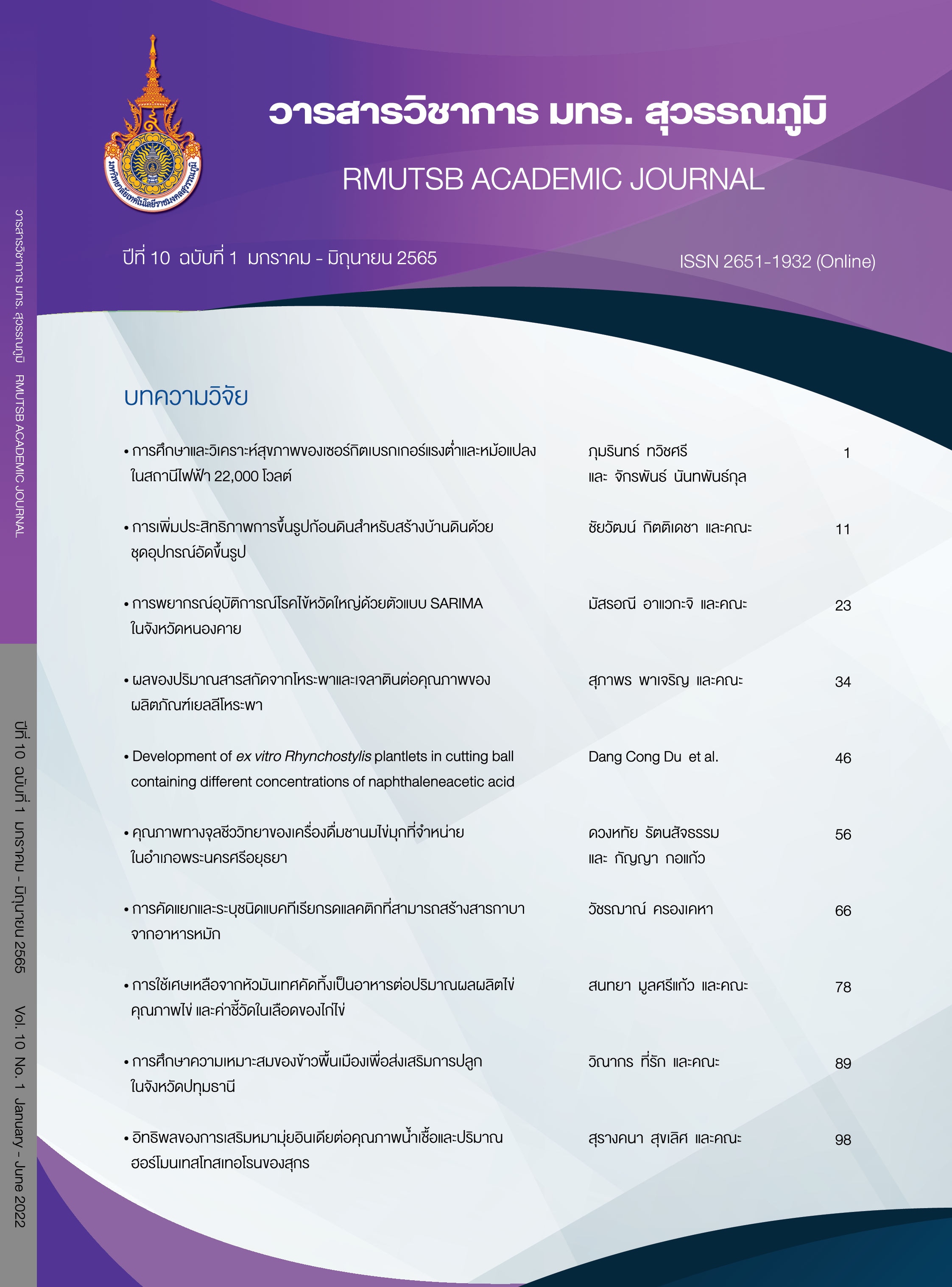Development of ex vitro Rhynchostylis plantlets in cutting ball containing different concentrations of naphthaleneacetic acid
Main Article Content
Abstract
The study was aimed to evaluate the effects of various concentrations of naphthaleneacetic acid (NAA) in encapsulated alginate as a cutting ball on ex vitro development of Rhynchostylis gigantea plantlets. NAA concentrations in a cutting ball caused particular effects on development of roots and leaves of R. gigantea plantlets. There was the changing of root diameter coincidentally followed by the altering of the rate of root initiation and average number of originated roots among treatments. The optimum time to carry ex vitro R. gigantea plantlets was 4 weeks. The NAA concentrations ranging from 1 to 2 ppm promoted better root development of ex vitro R. gigantea plantlets than other treatments. NAA concentration at 1 ppm gave the highest rate of leaf initiation, but it showed the lowest content of chlorophyll.
Article Details

This work is licensed under a Creative Commons Attribution-NonCommercial-NoDerivatives 4.0 International License.
Published manuscript are the rights of their original owners and RMUTSB Academic Journal. The manuscript content belongs to the authors' idea, it is not the opinion of the journal's committee and not the responsibility of Rajamangala University of Technology Suvarnabhumi
References
Arnon, D. (1949). Copper enzymes in isolated chloroplasts. Polyphenoloxidase in Beta vulgaris. Plant Physiology, 24(1), 1-15.
Bosabalidis, A. M., & Exarchou, F. (1995). Effect of NAA and GA3 on leaves and glandular trichomus of Origanum x intercedens Rech.: Morphological and anatomical features. International Journal of Plant Sciences, 156(4), 488-495.
Colombo, L. A., Faria, R. T., Assis, A. M., & Fonseca, I. C. B. (2005). Aclimatização de um híbrido de Cattleya em substratos de origem vegetal sob dois sistemas de irrigação. Acta Scientiarum. Agronomy, 27(1), 145-150. (English abstract)
Kanchit, T. (2016). Thai orchid genetic resources and their improvement. Horticulturae 2(3), 9.
Mandal, J., Pattnaik, S., & Chand, P. K. (2000). Alginate encapsulation of axillary buds of Ocimum americanum L. (hoary basil), O. basilicum L. (sweet basil), O. gratissimum L. (shrubby basil), and O. sanctum L. (sacred basil). In Vitro Cellular & Developmental Biology - Plant, 36(4), 287-292.
Parab, G. V., & Krishnan, S. (2012). Rapid in vitro mass multiplication of orchids Aerides maculosa Lindl. and Rhynchostylis retusa (L.) Bl. from immature seeds. Indian Journal of Biotechnology, 11, 288-294.
Rasmussen, H. N. (2002). Recent development in the study of orchid mycorrhizae. Plant Soil, 244, 149-163.
Sakhanokho, H. F., Pounders, C. T., & Blythe, E. K. (2013). Alginate encapsulation of Begonia microshoots for short term storage and distribution. The Scientific World Journal, 2013, 341568.
Sarkar, D., & Naik, P. S. (1998). Nutrient encapsulation of potato nodal segments for germplasm exchange and distribution. Biologia Plantarum, 40(2), 285-290.
Thitiphonkachit, T. (2021). Agricultural economics for farmers “confidence Thai orchid exports are still bright. Agriculture has accelerated assistance measures, confident in maintaining the world championship in the export market”. Retrieved 3 March 2021, from https://www.oae.go.th//assets/portals/1/fileups/publiccenter/files/%E0%B9%8CNews/radio/2021/Mar/03_03_64.pdf
Thomas, D. T., & Michael, A. (2007). High-frequency plantlet regeneration and multiple shoot induction from cultured immature seeds of Rhynchostylis retusa Blume., an exquisite orchid. Plant Biotechnology Reports, 1, 243-249.
Trappe, J. M. (2005). A. B. Frank and mycorrhizae: the challenge to evolutionary and ecologic theory. Mycorrhiza, 15, 277-281.
Xi, Y., Zeng, B., & Huang, H. (2021). Rapid propagation of Rhynchostylis retusa in vitro. Phyton International Journal of Experimental Botany, 90(3), 987-1001.


